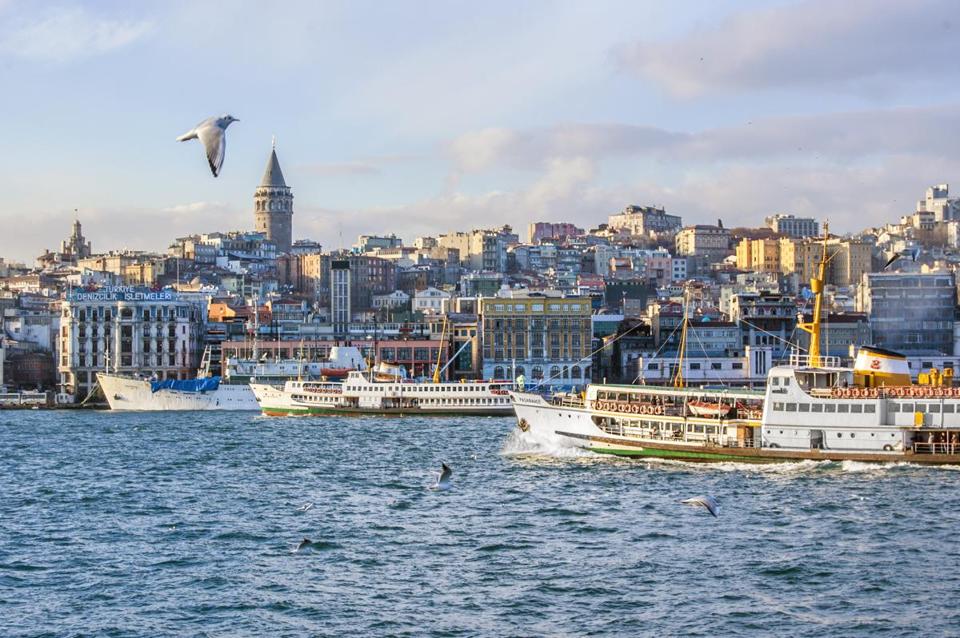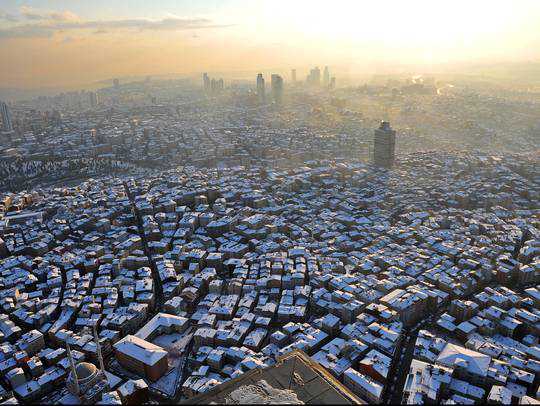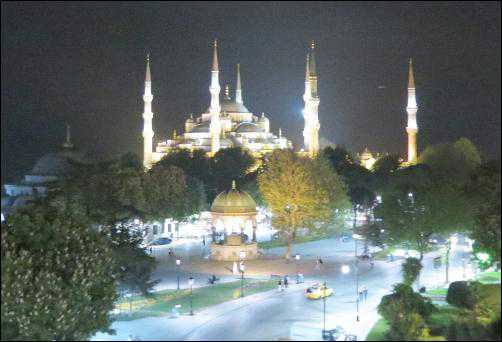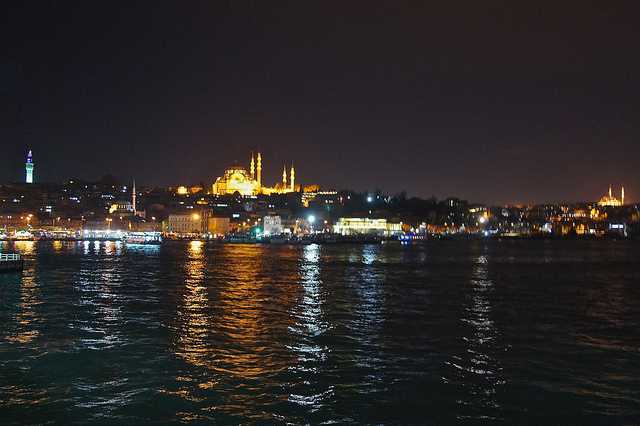to Istanbul
The problem with our hotel in Istanbul (the Neorion, a truly lovely place) is that it has a (free) snack bar in the afternoons: hummus, yogurt dip, sandwiches, soup, cakes… Ed looks at it, fills his plate and then tells me there’s no need to go out to dinner. No need to go out to dinner?! I think of Istanbul as one of the great places to eat and in ways that I cannot eat back home. The sea foods, the spices, the preparations are like nowhere else. Hummus, pea soup and sandwiches — we can do that at home!
I gave away the punchline to this day: we are in Istanbul. The fact is, we almost did not get here.
It was to be an easy journey from Crete. For all the predawn, long layover, short layover, complicated connections, etc etc that we often face, this one was easy: flight to Athens at 11. Connect there to Istanbul. Hotel provides free ride from Istanbul airport (winter bargains are intense now!).
I have to say, knowing that we’d be leaving Crete was a touch sad. Six nights at the Mama Nena gave us the feeling of having a home base. So now we were leaving home. One last early morning look out at the glorious colors of the old port…

I have a quick errand to run — replacements for the pack I left behind at a shop yesterday. So one last look at the market…


…at the cats high up on a ledge, stretching out in the morning sun.

One last breakfast, prepared with such care by Diana.

One last conversation with Matina (daughter of Mama Nena), one last swig of that great orange juice, one last piece of cake for Ed. (We finished off two olive oil cakes in the course of our stay here!)
And now it’s time for the fond good byes. And we’re out the sturdy, wooden Mama Nena door.

Even as the town of Chania begins her morning routines, as the mailman goes door to door on our narrow street…

…we are no longer part of it.
I’m thinking we’re a little tight on time. It’s 9:40, our flight leaves at 11, we still have our car rental to return. Even so, I linger by the harbor, taking in the view one last time: Mama Nena tucked between her neighbors at the harbor, with the White Mountains as a backdrop.

Ed is pushing forward. He checks his watch. Perhaps he’s a touch concerned that he lingered over breakfast too long.
Wait, what’s this? He’s on the retreat.
What’s wrong?
I can’t find the car keys. My immediate reaction is — oh my, do I have a juicy bit of absent mindedness to hold over you in future conversations! (Ed is always saying — did you lose something again?) My second reaction I express right there on the spot — are we going to miss our flight?
Ed can be brutally honest when I show concern — maybe.
He hurries back to the Mama Nena. Tick tock tick tock. It’s getting awfully close to ten. I consider our options: leave the car in the lot, grab a cab, pay for the missing keys and the nondelivery of the car. But do we even have time to now start calling for a cab?
I see Ed coming back. Found them. Fallen out of my pocket. Under the bed… I’m kind enough not to use this opportunity to comment on what happens when you throw your clothes on the floor. I’m so used to the floor serving as Ed’s closet wherever he is that there’s no point in saying much about it and especially not now when we have 65 minutes left before flight departure and the airport is 20 kilometers away.
Ed drives with an intensity I rarely see in him. We’ve done this stretch before. We’ve followed airport signs. We know where to go.
Except somehow we miss one of the turns. So much for intensity. We are now on our way to the ferry harbor.
Ed realizes our mistake and turns left to back track. Unfortunately his turn is onto a one way street. We’re going the wrong way. Cars pull to the side, I am shutting my ears and saying some constructive thing like oh no oh no oh no oh no!
Finally, he turns again, we find the proper road, we drop off the car and run into the tiny terminal.
Where we find that our flight has been delayed.
There’s a happy ending of course — you know that. The island hopper takes us to Athens in plenty of time for the big plane to Istanbul and so shortly after 4 we are in the heart of the old section of the city — the Sultanahmet, where our hotel, the Neorion, is located.
In a sense, we’re too close to the sights. Istanbul has three major land masses — the southern historic section –with the Sultanahmet), and across the Golden Horn waterway, the newer and in parts quite upscale Beyoglu, and then, across the Bosphorus — there is the Asian part – a more tranquil, mostly residential area. If you have time, the Asian part is delightful, especially if you’re lucky enough to have a view onto the Bosphorus. But we don’t have time – we leave in the middle of the night (Friday, before dawn) and so being close matters. And, the hotel, beloved by TripAdvisor, has terrific deals now and they try hard and it is very pretty — all in all, a thumbs up experience, except for the afternoon snack.

I suggest we walk some before the night sets in. It is to be a short walk, but one thing leads to another and it continues – on and on and on: from a peek at a pastry store around the corner…

to the ferry port at the Galata Bridge that spans the Golden Horn (the twinkle of lights now across the water is quite pretty; the ferry traffic here is unbelievable; the rush of people — palpable)…



In the distance, we can pick out the span of the Bosphorus Bridge: the portal to Asia.

So we’re at the crossroads of every thing and every place. And since we’re so close to the Galata Bridge, we may as well cross it (so many fishermen, swaying their poles, up and down, up and down…)

And now that we’re in the Beyoglu district, we may as well explore a little. Up the hill, past countless pomegranate juice stands again (it’s the season!)…

… and onto the main shopping street (Istiklal Ave) of the newer Istanbul, all the way to Taksim Square. There’s a quaint trolley that runs up and down this street, but we’re not trolleying, no sir, not us, we’re walking!

Our eyes are drawn toward the countless pastry and sweets stores (consider this bahlava pile, with honey dripping down its sides):

If you know your Istanbul, you’ll think (correctly) — that’s a hefty set of kilometers we’re covering. And we notice that it’s a good ten degrees cooler than in Crete. They say next week Istanbul will get zapped by snow. Now, in the evening, it’s still in the forties, but low forties.
A little cold, a little tired, I ask Ed if he’s hungry for dinner. No, not really. You eat. This is not a good time to dig out my restaurant wish list for the city. It’s a time to pick something simple. Something nearby. Something you can wrap in bread and eat by hand. Like maybe the place where they make these on the spot (Otantik Anadolu Yemekleri):

We share a spicy tomato dish, a salad, a spinach stuffed pancake and a wonderful chicken stew.


Cheap, fresh and honest. And Ed helps wipe the dishes clean with the thin flat breads.

The crowds of the city intensify as the evening wears on. The shopping street is a swarming mass of humanity, moving rapidly, with a purpose or maybe without a purpose. They say that on a weekend day, millions throng here. It’s not a weekend day, but surely a large fraction of those millions turned out tonight.
Finally, we’re at the bridge again, crossing it to return to Sultanahmet.
The shoreline shimmers and sparkles in the waters of the Golden Horn.

It surely is different than the little harbor of Chania. But it’s Istanbul, for God’s sake! A frenzied place of movement, of purpose. Nothing stands still, nothing shuts down just because it’s late. I ask the man at the pastry store — what time do you close? Never! – he says with a laugh. Somehow, I don’t think he was kidding.
https://ninacamic.blogspot.com/2013/01/to-istanbul.html





























